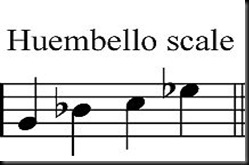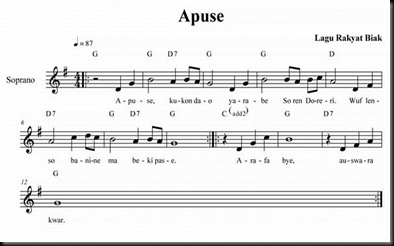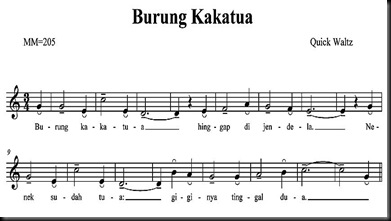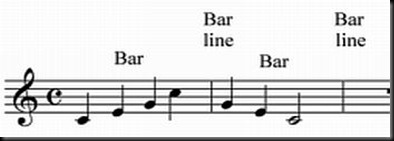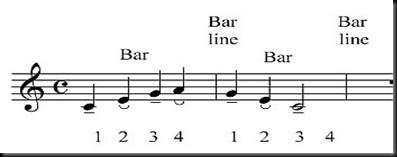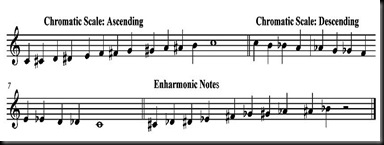Whether composed on the basis of the diatonic, chromatic, or natural minor scale, a melody has certain general characteristics. What are they?
Motive
The melody is formed from a core idea called a motive. In Western music, a motive is a short but recognizable melodic figure. It indicates the smallest possible subdivision in musical analysis.
A motive to a melody is like the central pillar to a house. From this central pillar, a constructor builds a house by adding other pillars, a framework, walls, and a roof. He also refines his work, paints the walls, adds decoration and ornaments as well as other construction details to such a degree that the house looks great, completely different from the first time its construction started with the central pillar. The motive is the central pillar; its development into fascinating details is the melodic development of the motive into a wonderful creation of musical pillars, framework, walls, roof, refinement, painting, decoration and ornaments as well as other details of sounds.
In the composition of Western melody, its motive is usually at its beginning, lasting for around two bars or measures. It can be repeated - by using the same or different tones - in other parts of the melody.
Here are some examples. The motive of the Christmas song, Silent Night, Holy Night, can be heard when the congregation sings, "Silent night, holy night". The core idea of Yamko Rambe Yamko, a Papuan folk song in a vernacular language which is popular in Indonesia, is at the beginning of the song where singers sing, "Hei, yamko rambe". G.F. Handel's Great Hallelujah has its melodic motive at the beginning of this great song where the choir sings "Hallelujah!" and then repeats the motive several times.
Note Combinations
A melody is composed through the combination of notes of various values and rest periods among notes. Notes sustained for some beats are combined with notes lasting for one beat, half a beat, a quarter beat, an eighth beat, a sixteenth beat, a thirty-second beat, and so on. The time for rest is usually indicated by a comma (where a singer stops temporarily to inhale) or a rest sign. In the tonic sol-fa (the "number or cipher notation") system, the rest sign is indicated by a zero (0).
A melodic composition needs time for rest. A melody without rest signs can be tiring for both a singer and listeners.
Scales
A melody is composed from a scale. The commonly used scales have already been explained.
Harmonic and non-harmonic tones
A melody can use harmonic or a combination of harmonic and non-harmonic tones. The harmonic tones are those used in various chords whereas the non-harmonic tones are those not being parts of chords but are inserted as variations among harmonic tones.
In the key of C major, the major C triad, for example, has the C-E-G notes. Each pair vertically forms the third interval. The three notes sound harmonic. They sound non-harmonic, however, when a note forming a second interval with its adjacent note is added. Because there are two pairs of third intervals, there are also two non-harmonic notes that are inserted: D between C-E and F between E-G. The combination of harmonic and non-harmonic tones results in an extended vertical sounding of notes: C-D-E-F-G.
The addition of non-harmonic tones to the harmonic ones is meant to smoothen the motion of a melody and produce certain musical effects. A bass guitar player who embellishes his harmonic with non-harmonic tones could make the melodic line he picks sound flexible and fascinating to listen to.
The melodic motion
A melody can show various motion. It can start with a high note then descends and ends with a low note. This is often the case with traditional melodies from Papua. For instance, Yamko Rambe Yamko, begins with the highest tonic note at its beginning and ends with its lowest tonic note. Besides, the melody can begin with the lowest note and ends with its highest. This is typical of Billy Joel's My Way. If you sing it in the key of C major, you will begin with its lowest note: G. You then move through various intervals, pitches, and rhythmic patterns higher and higher until you reach the climax of the song at the D note that corresponds to the word my in the last line: I did it my way. Still another melodic motion is comparable to climbing and going down a hill. You begin your singing journey by sounding a low note when you are in a valley, you step-wisely climb up and go down a hill several times, jump up and down over different steps, walk straight ahead, ascend to its highest peak and descend to its valley and stop for a rest there. This is the typical motion of Oh, Danny Boy, which was popularized in the 1960s by the wonderful baritone-bass male singer from America, Jim Reeves. A lot of great songs use the third motion.
Multiple keys and meters
A melody can move by using one or several key-notes. For example, it uses one key-note such as C major and then changes its key-note in the middle to E major before it returns to C major. The melody can also use one type of meter such as 4/4 or changes it: the melody begins with 4/4, then changes it to 2/4 on its way and ends its movement by going back to 4/4. There is clearly variation in the melodic motion.
Pentatonic scales
The influence of ethnic or traditional music results in the composition of songs based on pentatonic scales. The term "pentatonic" is derived from penta (five) and tonic, the adjective of tone, a noun; therefore, a pentatonic scale literally means a five-tone scale.
One of the scales seems to be widely used among a lot of ethnic groups, communities, and societies. In the key of C major, it consists of five notes: C-D-E-G-A. This type of pentatonic scale underlies the composition of traditional songs of various ethnic groups in Indonesia, such as the Papuans, Balinese, Javanese, Sundanese, and Bataks. The scale is termed laras slendro in Java and is noticeable in various folk songs in Javanese, such as Lir Ilir. It forms popular gospels of the Black-American communities in the USA, including Swing Low, Sweet Chariots, Joshua Fit the Battle of Jericho, and Nobody Knows the Trouble I've Seen; it also underlies the internationally famous Auld Lang Syne from the Scottish people and even various popular songs from China and Korea. An American popular song of the 1980s, Kung Fu Fighting, was based on the same scale. The Christians recognize it in that simple but enduring song, Amazing Grace.
Some Indonesian Christian composers used the pentatonic scale of that mode to compose some church songs for the congregation. Kidung Jemaat, a hymn book used particularly in main-stream Protestant and Catholic services in Indonesia, contains songs using this scale. Subronto Kusuno Atmodjo, a German-educated musician, used the scale to compose Betapa Kita Tidak Bersyukur. C. Akwan, a Papuan musician, used the same scale prevalent in the ethnic or traditional music of coastal Papuans in the northern part of Papua and West Papua to compose Gembala Baik Bersuling nan Merdu, one of the most beloved songs frequently sung in church services and recorded by Christian singers and musicians in Indonesia as well as in Holland. The same scale underlies, for example, Semua yang Tercipta by M. Karatem, an experienced musician from Southeast Mollucas in the eastern part of Indonesia. The song was published in Nyanyikanlah Kidung Baru, a hymn book used by the Indonesian Christian Church, a main-stream Protestant church.
Another pentatonic scale of a different mode and not so widely used is called laras pelog in Javanese. In the key of C major, it has the following notes: C-E-F-G-B.
The pentatonic scale with such a mode also formed the basis of some Christian compositions in Indonesia. Subronto Kusumo Atmodjo used this in Roh Kudus Turunlah and Puji Allah Pencipta published in Kidung Jemaat. The same hymn book contains a pelog song by Father Soetanta S.J., a Catholic priest and Dutch-educated musician. Rev. Dr. Sutarno, a former president of Satya Wacana Christian University in Salatiga, Central Java, composed two Christian pelog songs in Nyanyikanlah Kidung Baru: Ya Tuhanku, Kasihanilah Daku and Amin, Haleluya!. (Historically, the university was established around mid 1950s by main-stream Protestant educators from Indonesia, supported by the churches where they were members.) The three composers are Javanese.
In his book, Dr. J. Kunst mentioned anhemitonic scales also found in Dutch New Guinea. They have two, three, four or five tones.
Anhemitonic scales? What are they?
An anhemitonic scale is a shorter term for an anhemitonic pentatonic scale. We will look further into the one that has five tones. The tone area in this scale is divided into five different tones of an octave without semitones. The anhemitonic scale is also a term used in relation to primitive melodies with larger tonal range.
The complete tones of the C-D-E-G-A pentatonic scale that has five tones but without semitones should be C-D-E-G-A-C. The last C, though repeating the first, is one octave higher than the first. Each pair of tones forms a second major interval except the E-G and A-C pairs, each of which forms a third minor interval or four semitones. Its scale is also formed from two core melodies; each core has three notes. To understand this better, divide the six tones of this pentatonic mode into three. The lower three notes - C-D-E has E as its core melody; the higher three notes - G-AC has A as its core melody. Such a mode of pentatonic scale that has two core melodies and three notes for each core is a part of anhemitonic scales frequently noticed in primitive melodies.
Some other types of anhemitonic scales that are of pentatonic nature are as follows:
The name of each scale is derived from its lowest and highest notes. Each scale that has six notes is divided into two core melodies; each of them has three notes. The core melodies are indicated by the whole notes. The highest whole notes in the second and third scales are given but not counted because they are repetitions of their lowest tones of the same name. The lower three notes with the core melody of the first scale on the top left, for example, are EG-A; the higher three notes with their core melody are BD-E. It is not hard for you to analyze the core melodies and the notes of the other two scales.
Melodic range
Songs - that include melodies - are composed within certain range. For congregational or community singing, the lowest and highest limits of the range are average. If a song contains a note that sounds too low, singers with high voices such as soprano or tenor will face some difficulty in singing that note clearly. If the song contains a note that sounds too high, singers with low voices such as alto and bass will also face some difficulty in singing a note that sounds too low clearly. For solo singers, the melodic range is adapted to their suitable parts of voices, such as soprano, alto, tenor, and bas, and also to the melodic range achieved naturally - with no forced attempt.
Huembello, a traditional song from Ayamaru area in the western part of Dutch New Guinea, has a very limited tonal range. It has four tones, another example of the anhemitonic scale. To a certain extent, the scale reminds us of the blues scale. The song was modernized into a pop (funky) style and popularized in the late 1970s or early 198os by the Black Brothers, an Indonesian pop band from the former Irian Jaya - now Papua and West Papua. (For some unknown reasons, the group moved to Holland, Australia, and Vanuatu in the South Pacific.)
Diru-Diru Nina, a traditional pentatonic song from Yapen-Waropen in the northern part of Papua also modernized into an exciting reggae song by the same band, has a rather limited tonal range. The song which is a mixture of solo, duet, and trio has five tones sung by the lead singer. Simplified in the key of C major ( not the original key used by the Black Brothers), the five tones are C-D-E-G-A . The children's song from Biak, Apuse, composed by using the diatonic major scale uses one octave in its main melody. The song was also modernized into another pop song by the Black Brothers. Sajojo, a song in a Papuan language composed by one of the band members and also popularized for the first time in Indonesia by the band has nine notes. The famous Christmas hymn, Silent Night, Holy Night, uses eleven notes from the diatonic major scale: C-D-E-F-G-A-B-C-D-E-F. The last four notes sound higher than the previous ones. All these songs with different tonal range can be sung by a solo singer or by a group of singers.
Melodic forms
Modern melodies from Indonesia influenced by Western music adhere to certain forms. One of them is called the strophic form. Simply said, a song having a strophic form repeats exactly or almost exactly its lyrical verses. The simple gospel, Amazing Grace, has more than one verse; yet, each verse repeats the same melodic line. The song shows an example of strophic form. Another famous hymn, How Great Thou Art, is also strophic in its form. The first four bars of this Swedish folk song turned into a church song are repeated in the next four bars. Then comes the refrain whose first four bars are also repeated almost the same in the next four bars.
The opposite song form is called the non-strophic form. A non-strophic melody keeps changing and does not repeat its parts or itself.
Key-note and tempo
A melody has a key-note and a tempo. The key-note is known from the key signature of a musical composition. It may have one or more than one sharp (#) or flat (b) written at the beginning of the notation or neither of both. In the last case, the melody is in the key of C major. The tempo is indicated at the beginning of a composition like this: q=100 or MM=100. It means the song is played for 1oo beats per minute (bpm). MM stands for Maelzel's Metronome, a tool for measuring various music tempos, from the slowest to the fastest.
The metronome as we use it today was invented by D.N. Winckel, a Dutch instrument maker in Amsterdam, at the beginning of the 19th century. Then, Maelzel, an Austrian instrument maker from Vienna, did some improvement to Winckel's invention and exploited it after he established a metronome factory in Paris (France) in 1816. Since then, the metronome has been named after Maelzel despite the fact that it had been Winckel's invention.
Melodic form scheme
For the sake of melodic analyses, music experts have discovered a way to summarize so many notes in melodies into their essential notes and motion patterns. This technique is called melodic form scheme. The scheme is controlled by the type of scale used in a melody.
The essential note is represented by a harmonic half note while a non-harmonic note is represented by a quarter note. A non-harmonic note is not a part of the notes in a chord; for the sake of variation or creating a certain effect, the note is inserted into the chord.
Let us take the C major chord in the key of C major as an example. Its triad has the C-E-G notes that form harmonic or chord tones; each note forms a third interval with another. The triad becomes a mixture of harmonic and non-harmonic tones when other notes outside the key and chord are added. Two non-harmonic notes: D and F can be added; the D is inserted between C-E and the F is put between E-G. The added notes form a second interval with the three notes of the C major triad.
The Biak's folk song, Apuse, put in the key of G major has in its main melody all the diatonic tones of the scale except the second note (A). The primary chords used for this song indicate that there are some non-harmonic tones inserted here and there in some chords, all without any inversions.
The diatonic chord notes , in their triad and dominant-seventh structures, are as follows: G (G-B-D or doh-me-soh), D (D-#F-A or soh-te-ray), D7 (D-F#-A-C or ray-soh-te-ray-fah), and C (C-E-G or fah-lah-doh). All the notes form the harmonic tones of the chords.
The non-harmonic tones are found in the chords of D7 (B or me) in the second and sixth bars and of G (B and C or fah) in the fourth bar. They form some variation and effects in the chord tones.
The main melody of Apuse covers one octave, with the A note implied in its harmonic tones. Its starts with the lowest G and ends with its highest. The diatonic major G scale used includes G-B-C-D-E-F#-G (doh-me-fah-soh-lah-te-doh).
To summarize Apuse, the experts in music choose only one stemless note to represent each type of harmonic and non-harmonic tones in the main melody. Such a summary is technically termed by Kunst as a "melodic form scheme".
What is the melodic form scheme of Apuse, then? The following notation shows the scheme:
You will frequently come across the analysis of such essential pillars of melodies when you read the research of Dr. J. Kunst on the traditional music in Dutch New Guinea. By understanding its essence, you (if you are or want to be a musician) will be easily helped to develop other melodic schemes into typically Papuan music by neatly blending Papuan and modern music elements.
Harmony
Simply said, harmony is the structure of chords. The easiest way to understand harmony is by studying the triads of a diatonic major scale. There are within a scale such as C major two types of triads: primary and secondary triads. In their chord symbols, the primary triads in C major include C-F-G/G7. The secondary triads cover Dmin-Emin-Amin-Bdim. Each triad is formed from a third interval with different qualities. The triads become chords through the addition of one tone or more. The primary chords are major, including the dominant seventh chord G7. The first three secondary triads are minor and the last chord is diminished. They are all diatonic chords because they are formed from the notes of a diatonic major scale, such as C major.
The major chords are generally used to express an optimistic mood. The minor chords are usually used to convey an introspective mood. In vocal music, both types of mood are determined by the melodic form adapted to the meaning of its lyrics.
In addition to the chord structure, harmony also includes voicing. It is the choosing of chord tones you want to play or sing. A complete chord can have more notes than the ones you need to play on your guitar, piano, organ, or to make your song arrangement into two to four parts. A C13 chord, for example, has seven notes in the key of C major: C-E-G-Bb-D-F-A. You need three chord notes to play on your organ or piano and six others to strum on your guitar. Obviously, yo have to make some choices of which chord tones you need. The choices you make are called "voicing".
Harmony is a musical concept typical of Western music. It is not found in the traditional music of the Papuans in Netherlands New Guinea. What was often discovered by Kunst in his research was community singing (in unison). If he detected any voice blends similar to harmonized songs in the West, they did not follow the rules of Western harmony.
Related to harmony is the term "harmonics". It is a term used for the acoustic phenomena of music. The phenomena result from the fact that there are no pure tones that you can hear. (You can hear a pure tone, for example, from a tuning fork.) A pitch in harmonics is actually a composite, a blend, of many overtones also called partials . These notes are not heard as clearly as the the tone for which the pitch is named: the lowest note or fundamental. The overtones serve to establish the perceived timbre or tone-colors of the musical sound.
To illustrate, we will use the C note in the bass stave of the C major key as the fundamental note you can sound on your guitar. When you strike C, the fundamental note, on a string of your guitar, do you listen to that note only? Well, you listen to it clearly, but it is not the only note you perceive acoustically while you sound the string. If you listen closer, you will vaguely perceive other notes that sound together with the fundamental. These vague sounding notes can be another C an octave lower than the fundamental note, a B that forms a perfect fifth with the lowest C, an E, a G, and another B above the fundamental note. All notes other than the fundamental note (C) are called "overtones" or "partials". When you strike the guitar string, you actually sound a blend of the fundamental note and the vaguely distinctive other notes of the harmonics to create a certain tone-color of the string on your guitar.
Rhythm
Rhythm in the form of musical notation energizes the meaning of the lyrics in a song. The feeling for rhythm should therefore be compatible with the feelings in the words of the song.
In practice, the power of rhythm in the form of a musical notation is enhanced by musical accompaniment. In modern popular music, the musical accompaniment is called rhythm, style, idiom, tradition, genre. Those who are familiar with playing Yamaha PSR 3000 keyboard will notice various rhythms at Styles written near the top of the keyboard. You will notice the Ballad button that contains Classical Piano Ballad and the Hard Rock button. Each style is equipped with four types of buttons for rhythmic variation or breaks called "fill 1, fill 2, fill 3, and fill 4".
You can adjust your choices of the various rhythms at the keyboard with the atmosphere, mood, and meaning of the song you want to play. A good song should match or show some sort of "cooperation" with its rhythm and the meaning of its lyrics. If a lyrical message is mellow and is supported by its melody, the rhythm or style that supports both should also be mellow. Certain types of mellow ballads at the Yamaha keyboard are suitable for expressing a mellow message and melody. If a lyrical message and the melody that supports it are romantic, are marked by feeling and preferring grandeur, passion, and informal beauty, their relevant rhythm should also be romantic. Classical Pop Ballad at that keyboard is suitable for accompanying the romantic lyrics and melody. If the lyrical message is strong, the melody and its accompaniment should also be strong. Hard Rock matches the strong message and melody.
Enhancing a song atmosphere and mood through the unity of lyrics, melody, and style is a standard rule in composing and performing modern songs. This rule falls to pieces if a conflict occurs among the three of them. The energetic samba and salsa, on the one hand, become weak if you play either of one them using a relaxed or romantic idiom. The rhythm you use is not suitable. On the other hand, lyrics about an idyllic or pristine country or rural area become unsuitable if their melody moves energetically and fast and their musical accompaniment is lively like disco, funky, or heavy-metal rock. To make all of them congruous, the songs should be performed according to their typical styles, atmosphere, and the moods of their lyrics.
These idioms are related to dynamics. Any song needs energy. Even calm songs need intensity to enliven them. Rhythm helps enliven or energize music.
The Blending of All Musical Elements
In modern or Western music, all the general and specific elements should be blended to strengthen the main message of a song. A general rule about this says: All elements of a song should work together to heighten the feelings of the meaning of the message.
One application of this rule is the synchronization of melodic and word accents. A lot of modern songs in Indonesian, whether popular or classical, lack this principle of compatibility for reasons that are too many to be explained here. What can be said here is that composers of melodies and their lyrics with conflicting accents seem not to understand or not to have understood yet the rule about suitability.
For instance, there is a conflict of melodic and word accents in Burung Kakatua (the Cockatoo Bird), an old, Indonesian, quick-waltz, and popular song of the 1950s. If we read the beginning section of the lyrics following the normal Indonesian accents, such as those used by radio and television announcers, we can easily identify the strong accents (indicated by capital letters) and weak accents (indicated by small letters) of the words. The syllables getting strong accents are read louder than those getting weak accents.
BU-rung KA-ka-TU-a HING-gap DI jen-DE-la.
NE-nek SU-dahTU-a, gi-gi-NYA TING-gal DU-a.
(The cockatoo bird is perching at the window.
Grandmother is already old; she has two remaining teeth.)
(The word “gigiNYA” (her teeth) can also be accentuated on its second syllable: giGInya.)
The Indonesian lyrics follow Indonesian traditional poetry called pantun, similar in some way to limerick. Each pantun verse consists of two couplets; the first suggests the second by sound or similarity. In the old days, the pantun was often sung in contests where a boy addressed a quatrain to a girl who had to answer with a quatrain of her own. Some pantun are similar in their tone to limerick when they sound humorous in the second couplet.
What we hear, however, when we read the word accents by matching them with the melodic accents is incongruous to the point of evoking a humorous effect.
To get the effect, read the syllables of the words following the strong accents given on the first notes on the first counts of the measures (bars) - indicated by dashes - and the weak accents on other notes - represented by curvy lines. Your voice should sound louder on the strong accents.
Like Burung Kakatua, many other Indonesian songs show the same incongruity. They include popular songs (secular and religious), ethnic and national songs composed in Indonesian, and even church songs.
One of the few national songs whose melodic and word accents fit in perfectly is Maju Tak Gentar composed by Cornel Simanjuntak, a famous musician from Batak, North Sumatra. Few of the Christian hymn books that strictly obey the blending of all musical elements include Kidung Jemaat, Mazmur dan Nyanyian Rohani, and Nyanyikanlah Kidung Baru (to a certain extent).
Ready for Your Music Exploration
Your understanding of several aspects of the rudiments of Western music will hopefully make things easier for you to understand the research of Dr. J. Kunst on traditional Papuan music better. As we go along, I will explain other technical terms not covered in this chapter.


